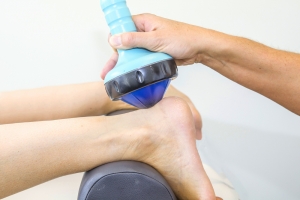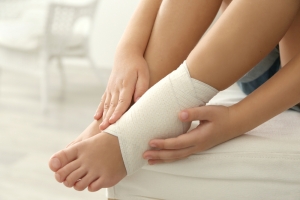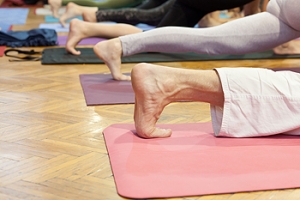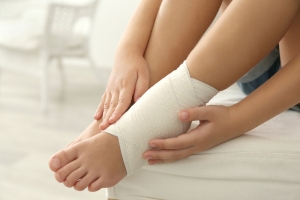Connect With Us
Featured Articles
Super User
Sesamoiditis
Sesamoiditis is a condition in which the sesamoid bones in the forefoot become inflamed from physical activity. Sesamoid bones are bones that are not connected to other bones but are located in tendons or muscle. Two of these sesamoid bones are very small and located on the underside of the foot near the big toe. Athletes such as runners, baseball and football players, and dancers are likely to experience sesamoiditis. Those with high arched feet, flat feet, or runners who run on the ball of their foot are also prone to suffer from sesamoiditis.
Symptoms include pain or throbbing on the ball of the foot near the big toe. The pain generally starts with a mild throbbing but gradually builds up to shooting pain. Bruising, swelling, and redness are possible, but in most cases, these symptoms are not present. However, moving the big toe can result in pain and difficulty.
To conduct a diagnosis, the podiatrist will examine the ball of the foot and big toe. They will look for any outliers and check the movement of the toe. X-rays will be taken to rule out any other conditions and ensure that it is sesamoiditis.
Treatment for sesamoiditis is generally mild and includes rest, anti-inflammatory and pain medication, and ice treatments to deal with the swelling and pain. Orthotics may be needed with people who have flat or high arched feet to relieve pressure off the bones. In some cases the toe will be taped and immobilized to allow healing. The podiatrist may also decide to use a steroid injection to help with swelling as well. If you have sesamoiditis, you shouldn’t engage in any intensive activity, as it may inflame the area and worsen your pain. If the sesamoid bone has fractured, surgery may be required to remove the sesamoid bone.
If you are suffering from sesamoiditis or are experiencing symptoms similar to sesamoiditis, you should stop all physical activity that puts strain on the area. Furthermore you should see a podiatrist for a diagnosis to see if you have sesamoiditis.
What Foot Conditions Can Shockwave Therapy Treat?
 The medical procedure that is known as shockwave therapy can be helpful in treating conditions that can affect the tissues and bones in the feet. Some of the ailments that can be treated can include plantar fasciitis, Achilles tendon injuries, and heel spurs. It is administered using low energy sound waves, and can easily penetrate the skin when an ultrasound gel is used. It is considered to be a non-invasive treatment for specific foot conditions, and many patients have little or no discomfort while undergoing this type of procedure. If you are afflicted with these foot conditions, it is recommended that you speak to a podiatrist who can determine if this is the best course of treatment for you.
The medical procedure that is known as shockwave therapy can be helpful in treating conditions that can affect the tissues and bones in the feet. Some of the ailments that can be treated can include plantar fasciitis, Achilles tendon injuries, and heel spurs. It is administered using low energy sound waves, and can easily penetrate the skin when an ultrasound gel is used. It is considered to be a non-invasive treatment for specific foot conditions, and many patients have little or no discomfort while undergoing this type of procedure. If you are afflicted with these foot conditions, it is recommended that you speak to a podiatrist who can determine if this is the best course of treatment for you.
Shockwave therapy is a treatment commonly used to treat various injuries and conditions, particularly plantar fasciitis in the feet. To learn more, consult with Dr. Howard Horowitz from Bowie Foot & Ankle . Our doctor can provide the care you need to keep you pain-free and on your feet.
Shockwave Therapy
Shockwave therapy is a new treatment option designed to treat bone conditions such as tennis elbow, shoulder pain, and others. Shockwave therapy uses high intensity sound waves that are directed to the affected tissues of the body with pinpoint accuracy. The effects are very beneficial, leading to a production of collagen fibers, eliminating inflammation.
Who Benefits from Shockwave?
Shockwave is recommended for patients suffering from heel pain and associated problems. Heel pain is a common condition which can be caused by obesity, overexertion, and spending a substantial amount of time on hard floors with your feet exposed and unsupported.
Fast and Easy
The therapy is actually a simple process that can leave patients feeling better the very next day. Shockwave therapy is not as dramatic as it sounds. It enables more blood flow to effected areas, addressing the source of the problem and allowing treatment to last for a long time.
Treatment & Recovery Time
Shockwave treatment will enable your feet to recover quickly. This is especially important since surgery is not required. It is cost effective and does not require the use of anesthesia. This treatment is a better option to surgery, since it is proven safe.
If you have any questions, please feel free to contact our office located in Bowie, MD. We offer the newest diagnostic and treatment technologies for all your foot and ankle needs.
Read more about Shockwave TherapyShockwave Therapy
Extracorporeal Shockwave Therapy (ESWT) is an alternative treatment method that is used for bone and soft tissue disorders in the foot and ankle. EWST is a noninvasive option for pain relief and it was originally created to help dissolve kidney stones. This therapy works by focusing impulses to target the area in pain. This method has been proven to show a reduction in the amount of nerve fibers that transmit painful impulses, which leads to a reduction in pain. Shockwave therapy can also expedite the tissue which would, in turn, increase the amount of new blood vessels that are formed.
Conditions that can be treated with shockwave therapy include Achilles pain and heel pain. People with plantar fasciitis may opt for this therapy and the results are usually great after 18 months. Additionally, this method can also be used to treat fractures that have failed to heal correctly. Anesthesia is not required to perform this treatment. It usually is not painful, but it can be uncomfortable.
The duration of treatment sessions usually lasts 5-15 minutes each. This procedure is safe since there is no risk of infection from wound complications, if you are looking to try shockwave therapy to heal plantar fasciitis, it may take 3-4 sessions to start working. After treatment, patients typically notice a dull pain in the area which was treated. However, this pain rarely lasts more than 24 hours.
Nevertheless, there are pros and cons that come along with Shockwave Therapy. The most obvious pro is that this treatment is noninvasive, meaning surgery will not be required. Another upside is that there have been very little complications that have been found with this procedure. On the other hand, those who opt for surgery are at risk for continued pain, wound problems, and infections. The biggest con for ESWT is that it is very expensive; it typically costs around $1,000 before insurance. Another con is that the effectiveness of the treatment is questionable. Usually, if this treatment is helpful, the difference is small.
If you are curious about Shockwave Therapy, you should talk to your podiatrist to see if this treatment method is right for you. At times, patients will find that there are other treatment options that are more efficient for their individual cases.
Common Reasons for Ankle Pain
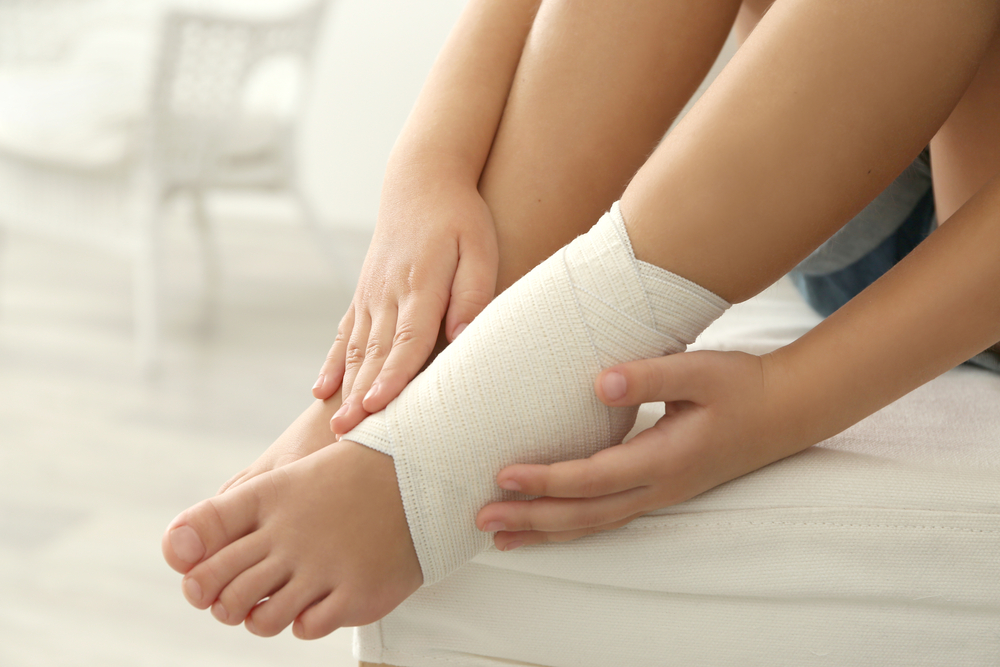 Your ankle can hurt for a variety of reasons. The most common cause of ankle pain is an injury, such as a strain or a sprain. A strain is an injury to the muscle or tendon of the ankle, while a sprain is an injury to the ligament. Both types of injuries can vary in severity and may cause pain or discomfort, tenderness, and swelling. Other possible injuries of the ankle include Achilles tendon ruptures or ankle fractures, which are more severe in nature. Several types of arthritis can affect the ankle, including osteoarthritis, rheumatoid arthritis, and gout. An infection, in which bacteria enters the skin or the joint around the ankle can cause pain and swelling, in addition to fever and fatigue. Flat feet or fallen arches may lead to ankle pain as well. If you are experiencing ankle pain, it is recommended that you see a podiatrist for a proper diagnosis and to begin the best course of treatment that is right for you.
Your ankle can hurt for a variety of reasons. The most common cause of ankle pain is an injury, such as a strain or a sprain. A strain is an injury to the muscle or tendon of the ankle, while a sprain is an injury to the ligament. Both types of injuries can vary in severity and may cause pain or discomfort, tenderness, and swelling. Other possible injuries of the ankle include Achilles tendon ruptures or ankle fractures, which are more severe in nature. Several types of arthritis can affect the ankle, including osteoarthritis, rheumatoid arthritis, and gout. An infection, in which bacteria enters the skin or the joint around the ankle can cause pain and swelling, in addition to fever and fatigue. Flat feet or fallen arches may lead to ankle pain as well. If you are experiencing ankle pain, it is recommended that you see a podiatrist for a proper diagnosis and to begin the best course of treatment that is right for you.
Ankle pain can be caused by a number of problems and may be potentially serious. If you have ankle pain, consult with Dr. Howard Horowitz from Bowie Foot & Ankle . Our doctor will assess your condition and provide you with quality foot and ankle treatment.
Ankle pain is any condition that causes pain in the ankle. Due to the fact that the ankle consists of tendons, muscles, bones, and ligaments, ankle pain can come from a number of different conditions.
Causes
The most common causes of ankle pain include:
- Types of arthritis (rheumatoid, osteoarthritis, and gout)
- Ankle sprains
- Broken ankles
- Achilles tendinitis
- Achilles tendon rupture
- Stress fractures
- Bursitis
- Tarsal tunnel syndrome
- Plantar fasciitis
Symptoms
Symptoms of ankle injury vary based upon the condition. Pain may include general pain and discomfort, swelling, aching, redness, bruising, burning or stabbing sensations, and/or loss of sensation.
Diagnosis
Due to the wide variety of potential causes of ankle pain, podiatrists will utilize a number of different methods to properly diagnose ankle pain. This can include asking for personal and family medical histories and of any recent injuries. Further diagnosis may include sensation tests, a physical examination, and potentially x-rays or other imaging tests.
Treatment
Just as the range of causes varies widely, so do treatments. Some more common treatments are rest, ice packs, keeping pressure off the foot, orthotics and braces, medication for inflammation and pain, and surgery.
If you have any questions, please feel free to contact our office located in Bowie, MD. We offer the newest diagnostic and treatment technologies for all your foot care needs.
Read more about Ankle Pain
Ankle Pain
Pain experienced in the ankle can be caused by a multitude of conditions. While the most common cause is an ankle sprain, other possible problems can include arthritis, gout, ankle instability, ankle fracture, nerve compression, or tendinitis. In more serious cases, ankle pain can be a sign of improper alignment of the foot or an infection.
Ankle pain can often be accompanied by symptoms such as redness, swelling, stiffness and warm in the affected area. Pain can be described differently depending on the condition; short, stabbing pain and a dull ache are some examples. If such symptoms are persistent and do not improve after time, be sure to schedule an appointment with your local podiatrist.
Depending on the condition behind your ankle pain, different treatments may be prescribed by your podiatrist. For ankle sprains, the first step in treatment involves rest, ice, elevation, and compression. Be sure to avoid placing pressure on the ankle, use an ice pack several times a day, and use a compression bandage and elevation to reduce swelling. Other more serious conditions may require the assistance of certain drugs and medications such as nonsteroidal anti-inflammatory drugs (NSAIDs), physical therapy, or even cortisone injections.
Consult with your foot and ankle doctor to best determine the cause of your ankle pain and the appropriate treatment. Depending on the severity of your ankle pain and the condition behind it, recovery from ankle pain may take some time.
Why Are Foot Exercises Important?
 Exercising the feet may seem trivial, but in reality, it is very important. The feet are the foundation upon which the entire body stands, and they support your weight all day, allowing you to be mobile and complete your daily activities. Practicing foot exercises can keep your feet strong and flexible, which can reduce foot and ankle pain, decrease muscle soreness, prevent injuries, and keep you healthy and active. You may want to choose a foot exercise regime that focuses on increasing your range of motion, improving your flexibility, and strengthening the muscles of the feet. If you have existing foot pain, an injury, arthritis, diabetes, or any other foot condition, it is suggested that you speak with a podiatrist prior to starting an exercise program.
Exercising the feet may seem trivial, but in reality, it is very important. The feet are the foundation upon which the entire body stands, and they support your weight all day, allowing you to be mobile and complete your daily activities. Practicing foot exercises can keep your feet strong and flexible, which can reduce foot and ankle pain, decrease muscle soreness, prevent injuries, and keep you healthy and active. You may want to choose a foot exercise regime that focuses on increasing your range of motion, improving your flexibility, and strengthening the muscles of the feet. If you have existing foot pain, an injury, arthritis, diabetes, or any other foot condition, it is suggested that you speak with a podiatrist prior to starting an exercise program.
Exercising your feet regularly with the proper foot wear is a great way to prevent injuries and build strength. If you have any concerns about your feet, contact Dr. Howard Horowitz from Bowie Foot & Ankle . Our doctor can provide the care you need to keep you pain-free and on your feet.
Exercise for Your Feet
Exercise for your feet can help you gain strength, mobility and flexibility in your feet. They say that strengthening your feet can be just as rewarding as strengthening another part of the body. Your feet are very important, and we often forget about them in our daily tasks. But it is because of our feet that are we able to get going and do what we need to. For those of us fortunate enough to not have any foot problems, it is an important gesture to take care of them to ensure good health in the long run.
Some foot health exercises can include ankle pumps, tip-toeing, toe rises, lifting off the floor doing reps and sets, and flexing the toes. It is best to speak with Our doctor to determine an appropriate regimen for your needs. Everyone’s needs and bodies are different, and the activities required to maintain strength in the feet vary from individual to individual.
Once you get into a routine of doing regular exercise, you may notice a difference in your feet and how strong they may become.
If you have any questions please feel free to contact our office located in Bowie, MD. We offer the newest diagnostic and treatment technologies for all your foot and ankle needs.
Read more about Exercise for Your FeetExercise for Your Feet
Whether your feet are over-worked or under-worked, chances are they could benefit from some special attention. Even those who exercise regularly probably do not spend any time strengthening their feet. This can be just as rewarding as strengthening the rest of the body, since the health of your feet affects the health of the rest of the body as well, especially the ankles, legs, and spine.
For those who might not have any idea on how a foot-specific exercise might be conducted, there are several workouts that are fairly easy to perform in the comfort of ones’ home. One of the easiest is the toe rise, also known as the tip-toe. This exercise involves standing on the tip-toes for a count of 15 then resting the feet on the ground. This process should be repeated a minimum of three times a day in order to strengthen the feet.
Toe pick-ups strengthen the feet by working them in a very different way. In this exercise, small items are picked up using the toes in order to strengthen the muscles on the upper part of the feet. Once again three sets should be performed, with the item in question being held for 15 seconds then dropped. Items that may be picked up using the feet include marbles and even stationery, which works wonders for the toes and the surrounding muscles.
Yet another simple workout is the ankle pump. This can be done either upwards or downwards, but for the workout to be most effective both can be incorporated into the routine. As the term suggests, this involves lifting the foot off the floor and flexing the toes either towards the shin or towards the ground. This movement puts the feet and ankles through a large range of motion which works the muscles.
Last but not least, feet should be stretched so that the muscles can relax and recuperate. This can be done by placing both feet off of the floor and bracing oneself against the wall at a 45 degree angle. This ensures that the feet and ankles are adequately stretched once the workout is complete.
In short, giving the feet a good workout every now and then is important in order to avoid problems such as plantar fasciitis. It’s also important to warm-up or cool-down after running or vigorous walking. Foot exercises may be followed by a good foot massage. This encourages circulation in the feet as well as muscle relaxation.
Types of Ankle Sprains
 Many people who participate in sporting activities that involve running and jumping may experience ankle sprains. A low ankle sprain occurs on the outside of the ankle, and is considered to be a common type of sprain. When the affected ligaments are above the ankle, it is categorized as a high ankle sprain. Common symptoms in both types of sprains include severe pain and discomfort, and it is often difficult to walk. Effective treatment for mild sprains include resting and elevating the affected foot, and this may be helpful in reducing existing swelling. Sprains that are moderate may require the patient to wear a boot, which can be beneficial in stabilizing the ankle as the healing process occurs. Severe sprains may require the patient to undergo physical therapy. If you have endured an ankle sprain, please speak to a podiatrist who can determine what the best treatment is for you.
Many people who participate in sporting activities that involve running and jumping may experience ankle sprains. A low ankle sprain occurs on the outside of the ankle, and is considered to be a common type of sprain. When the affected ligaments are above the ankle, it is categorized as a high ankle sprain. Common symptoms in both types of sprains include severe pain and discomfort, and it is often difficult to walk. Effective treatment for mild sprains include resting and elevating the affected foot, and this may be helpful in reducing existing swelling. Sprains that are moderate may require the patient to wear a boot, which can be beneficial in stabilizing the ankle as the healing process occurs. Severe sprains may require the patient to undergo physical therapy. If you have endured an ankle sprain, please speak to a podiatrist who can determine what the best treatment is for you.
Although ankle sprains are common, they aren’t always minor injuries. If you need your ankle injury looked at, contact Dr. Howard Horowitz from Bowie Foot & Ankle . Our doctor can provide the care you need to keep you pain-free and on your feet.
How Does an Ankle Sprain Occur?
Ankle sprains are the result of a tear in the ligaments within the ankle. These injuries may happen when you make a rapid shifting movement while your foot is planted. A less common way to sprain your ankle is when your ankle rolls inward while your foot turns outward.
What Are the Symptoms?
- Pain at the sight of the tear
- Bruising/Swelling
- Ankle area is tender to touch
- In severe cases, may hear/feel something tear
- Skin discoloration
Preventing a Sprain
- Wearing appropriate shoes for the occasion
- Stretching before exercises and sports
- Knowing your limits
Treatment of a Sprain
In many cases, the RICE method (Rest, Ice, Compression, and Elevate) is used to treat ankle sprains. However, you should see a podiatrist to see which treatment option would work best with your injury. In severe cases, surgery may be required.
It is important to ask your doctor about rehab options after you receive treatment for your injury. Stretching, strength training, and balance exercises may help the ankle heal while also preventing further injury.
If you have any questions, please feel free to contact our office located in Bowie, MD. We offer the newest diagnostic and treatment technologies for all your foot care needs.
Read more about Ankle SprainsAnkle Sprains
Ankle sprains occur when ligaments that support the ankle stretch beyond their limits and tear. These types of injuries are very common and can occur in people of all ages. Sprains may range from mild to severe, depending on how much damage is done to the ligaments. If a sprain goes untreated, a more severe sprain may occur which can further damage the ankle. Repeated ankle sprains can lead to chronic ankle pain.
There are some risk factors that can increase your risk of suffering a sprained ankle. Those who participate in sports, walk on uneven surfaces, have a prior ankle injury, are in poor physical condition, or wear improper shoes are more likely to get a sprained ankle.
There are a few symptoms to look out for if you suspect you are suffering from a sprained ankle. Some common symptoms are swelling, bruising, tenderness, and instability of the ankle. In cases where the tearing of the ligaments is severe, there may be a “popping” sound when the strain occurs.
The RICE method is proven to be effective in treating ankle sprains. RICE stands for Rest, Ice, Compression, and Elevation. Rest is important for treatment especially within the first 24 to 48 hours. You should also ice your sprained ankle for the first 48 hours for 20 minutes at a time. A small piece of cloth should be placed between the ice and the affected area. For the compression step, you should wear a brace that is snug, but not too tight that it cuts off circulation. When choosing a brace, be sure to choose one that is suitable for the type of ankle sprain you have. Lastly, you should elevate your foot above the heart as often as possible.
After you treat a sprain, you should go through rehabilitation to prevent the injury from occurring again. There are three phases to the rehab process. The first phase involves resting, protecting and reducing the swelling of the injury. The second phase consists of restoring the ankles flexibility, range of motion, and strength. The third phase consists of slowly returning to activity and maintenance exercises.
If you suspect you have an ankle sprain, you shouldn’t hesitate to consult with your podiatrist. Your podiatrist will be able to give you a proper diagnosis and a suitable treatment option for your condition.


